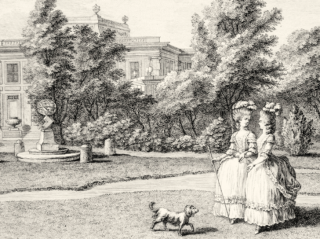Carmontelle’s Jardin de Monceau
Posted in Humanities Institute on November 29 2017, by Vanessa Sellers

On September 7, 2017, The New York Botanical Garden’s Humanities Institute and the Foundation for Landscape Studies, New York, co-hosted the Colloquium Carmontelle’s Jardin de Monceau: Celebrating the unique Garden Culture of 18th-century France, held in the LuEsther T. Mertz Library’s Shelby White and Leon Levy Reading Room.
The Colloquium marked the starting point of an important project: the publication of a facsimile edition in English of the richly illustrated Jardin de Monceau, an impressive folio-sized volume by Louis Carrogis de Carmontelle (1717–1806), published in Paris in 1779. Designed by Carmontelle for the Duc de Chartres, the actual garden of Monceau still survives today, though in different form, as the much-frequented Parc Monceau at the heart of Paris. The original layout of the garden, with its rich architectural and sculptural features, formed an ideal social setting for the fashionable elite shortly before the French Revolution—a watershed moment in European history that would bring to an end the glamorous lifestyle and mode of garden design reflected in this work. Carmontelle’s Jardin de Monceau is a key cultural monument in the history of European landscape design, garden architecture, and horticulture, as well as printmaking and fashion design.

After a welcome word by Vanessa Sellers, Research Coordinator of the Humanities Institute, Elizabeth Barlow Rogers, President of the Foundation for Landscape Studies, gave an introduction, explaining in broad strokes the plans for the republication of this historical work. A careful English translation of the text will be augmented with new scholarly essays that will provide further explanations about the layout of the gardens, its elegant buildings and whimsical follies, and finally an art-historical overview of Carmontelle’s own accomplishments as an artist (painter and set designer). Betsy Rogers then proceeded to introduce the speakers, each of whom had already published an important article on the topic in Site/Lines, the Foundation for Landscape Studies’ biannual journal.
The speakers were: David Hays, Associate Head of the Department of Landscape Architecture, University of Illinois at Urbana-Champaign, who explained the acquisition and subsequent development of the garden grounds in a presentation entitled History by Design: the Aesthetics of Transformation in Carmontelle’s Design for the Jardin de Monceau; Joseph Disponzio, Preservation Landscape Architect for the Department of Parks and Recreation of the City of New York, who spoke about the layout of the garden in relation to Carmontelle and his patrons, in Louis Carrogis de Carmontelle’s Jardin de Monceau: A Spade in the Garden or a Garden in Spades; and finally, Elizabeth Hyde, Associate Professor and Chair of the Department of History, Kean University, NJ, who closed the afternoon’s overview of the Jardin de Monceau by focusing on the plants in the garden and newly discovered historical botanical lists in a presentation entitled Breaking the ‘habit of seeing the same objects,’ or Planting the Picturesque in Eighteenth-Century France.

After the presentations, the audience had an opportunity to view important period works from the Mertz Library’s own collection, including the text and all 18 plates in Carmontelle’s own exquisite volume.
During the closing reception, many of the participants exclaimed that they were looking forward to having in the near future a solid English translation of de Jardin de Monceau, with added articles, comments, and color images, so they could learn more about this extraordinary work and the world it formed an important part of.


SO sorry I couldn’t be there – I love this garden. Its history is also intimately linked to that of Bagatelle, where some of the 18th century elements can still be viewed. I would be happy to help with any translation questions – I have lived in France for nearly 30 years, and work as a guide in the botanical gardens. Kindly, Amy Kupec Larue